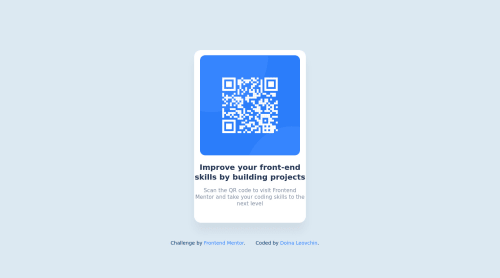Responsive QR code component

Solution retrospective
Hello there! This is my first completed project here! I found the overflow property to be useful while working on it. I'm open to any advice or suggestion! Thank you so much!
Please log in to post a comment
Log in with GitHubCommunity feedback
- @correlucas
👾Hello again Doine, Congratulations on completing this challenge!
I've some suggestions for your old solution:
1.Don’t use
idto give the style of your elements, its not a good idea becauseidits a too much specific selector used forformsand Javascript code. Instead, useclassfor styling and let theidfor much specific stuff. Its also not advisable to use IDs as CSS selectors because if another element in the page uses the same/similar style, you would have to write the same CSS again. Even if you don't have more than one element with that style right now, it might come later.2.Replace the
<h3>heading with<h1>note that this title is the main heading for this page and every page needs one h1 to show which is the most important heading. Use ever the sequence h1 h2 h3 h4 h5 to show the hierarchy of your titles in level of importance, never jump a level.3.The html structure is fine and works, but you can reduce at least 20% of your code cleaning the unnecessary elements, you start cleaning it by removing some unnecessary
<div>. For this solution you wrap everything inside a single block of content using<div>or<main>(better option for accessibility) and put inside the whole content<img>/<h1>and<p>.<body> <main> <img src="./images/image-qr-code.png" alt="Qr Code Image" > <h1>Improve your front-end skills by building projects</h1> <p>Scan the QR code to visit Frontend Mentor and take your coding skills to the next level</p> </main> </body>✌️ I hope this helps you and happy coding!
Marked as helpful
Join our Discord community
Join thousands of Frontend Mentor community members taking the challenges, sharing resources, helping each other, and chatting about all things front-end!
Join our Discord